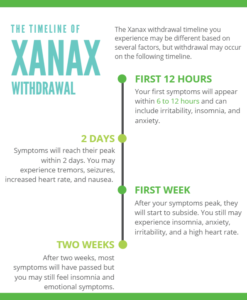While many people are familiar with the opioid epidemic, they may not be as aware of another drug abuse epidemic. Addiction to prescription medications known as benzodiazepines has been on the rise since the late 1990s. And in 2013, overdoses from benzodiazepines accounted for 31 percent of the 23,000 prescription drug overdose deaths in the U.S.
Benzodiazepines are tranquilizers, and they are often prescribed for conditions such as anxiety, insomnia, alcohol withdrawal, seizures, and as an anesthetic given before surgery. These drugs affect the central nervous system and produce a strong sensation of relaxation. Xanax (alprazolam) is a common type of benzodiazepine. Xanax and other benzodiazepines tend to be highly abused because of the sedative effects they produce and the ease of obtaining them.
If dosing instructions aren’t followed carefully, it can be easy to develop a Xanax dependency or accidentally overdose. Xanax withdrawal is marked by uncomfortable symptoms. Attempting to quit this or any other benzodiazepine on your own is dangerous. Learn more below about Xanax withdrawal symptoms and the stages of addiction treatment.
What Are The Xanax Withdrawal Symptoms?
Symptoms of Xanax withdrawal may include:
- Insomnia and sleep disturbance
- Irritability
- Agitation
- Anxiety
- Panic attacks
- Shaky hands
- Sweating
- Problems concentrating
- Dry heaves
- Nausea
- Weight loss
- Heart palpitations
- Headache
- Muscle aches and stiffness
- Seizures
- Psychotic reactions
Factors That Influence Withdrawal
Several factors can influence how you experience withdrawal. They contribute to the severity and duration of your withdrawal period. According to Verywell Mind, the following factors that can influence withdrawal include:
- The amount of your current dose of Xanax
- The length of time you’ve been taking it
- Whether you take more than one kind of benzo
- Whether you take other depressant medications
- If you have any existing substance abuse issues
- Whether you are quitting more than one substance at a time
Tingling or numbness in the hands or legs
Research indicates that about 40 percent of people who take Xanax for more than six months will experience withdrawal symptoms that range from moderate to severe. The other 60 percent are expected to experience milder symptoms, reports Verywell Mind.
What Are the Stages in the Xanax Withdrawal Timeline?
Withdrawal from this drug and other benzodiazepines usually follow a few different stages. Withdrawal from Xanax has been found to be more extreme than from other benzodiazepines.
The following is a general timeline of how Xanax withdrawal manifests:
- Six -12 Hours: Xanax withdrawal symptoms can start to manifest during this period. The most common symptoms that occur in this frame are insomnia and anxiety.
- Days 1-4: This is the peak period of Xanax withdrawal when symptoms are at their most intense. Nausea and vomiting can occur, along with heightened anxiety and insomnia.
- Days 5-14: The physical symptoms of withdrawal will subside, during this period, and the psychological ones like anxiety and irritability will also lessen. Those mental effects may continue.
- Two weeks and beyond: A protracted withdrawal syndrome may develop at this time. This particular condition is called post-acute withdrawal syndrome or (PAWS). When someone has PAWS, they can experience anxiety and other symptoms that can last for six months or more after the severe or peak withdrawal period. Other PAWS symptoms include:
- Depression
- Insomnia
- Tinnitus (ringing in the ears)
- Muscle pain and weakness
- Body tremors or jerking
- Anxiety
- Cognitive impairment
- Tingling or numbness in the hands or legs
- Tension
- Gastrointestinal problems
Why Should I Detox?
It can be difficult and painful to quit using drugs cold turkey, and in some cases, including Xanax withdrawal, it can be dangerous.
Withdrawing on your own without professional medical help can be very challenging and dangerous, given the difficult physical symptoms that often result.
Finding a professional, medically-assisted detox program to support you during Xanax withdrawal ensures that you are carefully monitored in a safe environment while your body goes through the difficult, and sometimes painful, detoxification process as it eliminates the physical need for the drug. You will have a better chance of lasting recovery because of the structured medical and emotional support provided in an addiction treatment program.
What Is the Next Treatment Step?
Following a full continuum of treatment begins with the highest and most intense level of care during the detox phase and then progresses through less intense levels of treatment. Going through all stages of treatment will position you to be successful in your recovery. These stages usually include detox/inpatient, partial hospitalization, intensive outpatient, and alumni or aftercare.

Detox
During the first stage of withdrawal treatment, the goal is medical stabilization through detox. The medical team, which includes doctors, nurses, and support staff, will give you a complete medical assessment to determine your level of addiction and any additional medical needs you may have. This process will include a medical exam and urine or blood tests to screen for drugs.
Depending on these results, your physician may also require additional testing such as additional blood tests, including a CBC (complete blood count), chest X-ray, ECG (electrocardiogram), and testing for other diseases.
Once the doctor has these test results, a detox plan will be created for you. Then, under the care of your medical team, you will begin the detox process. Detoxing from Xanax may also include the administration of other monitored prescription medications such as Valium.
Your treatment plan will also include emotional support as you begin addiction therapy because many people also experience anxiety, depression, and other emotional and psychological challenges as they detox.
Partial Hospitalization
After completing the detox phase of treatment, the next stage is to continue treatment in a partial hospitalization program. You’ll live at a transitional living facility while undergoing a supportive, rigorous, and structured treatment program five days a week for six hours each day. You will be able to participate in individual, group, and family therapy programs to address your emotional and mental health needs.
You will focus on learning positive life skills, coping mechanisms, and techniques to help prevent relapse so that you can be better prepared for long-term recovery. This training will help you begin the process of returning to your life outside the treatment center.
Intensive Outpatient
Each stage of the full continuum of treatment slowly moves you back to life outside the rehab facility while helping you build the skills and resources needed to cope with and avoid relapsing. Once you have completed the inpatient program, you will move into the intensive outpatient program (IOP) stage.
Sometimes outpatient treatment is used as standalone addiction therapy, but it is also a key part of a full continuum of treatment. Your therapy sessions at this stage won’t be as frequent, and the program will offer more flexibility, but you will still attend intensive therapy sessions and continue with medication management if needed.
This stage of treatment will help you continue to be accountable for your recovery and will also include periodic weekly testing. The main focus of IOP is continuing to build coping skills and preventing relapse.
Alumni
After you finish the treatment program, you will have the opportunity to join other treatment center alumni for weekly support groups and social events. These opportunities to meet other program graduates can help you develop new friendships and build social support with others who understand the recovery process.
This support network can help you grow and remain focused on your recovery as you continue to adjust to life after the treatment program and take on new responsibilities.
(2018). A Review of Alprazolam Use, Misuse, and Withdrawal. Retrieved from https://www.ncbi.nlm.nih.gov/pmc/articles/PMC5846112/
Overdose Deaths from Common Sedatives Have Surged, New Study Finds. Retrieved from http://www.einstein.yu.edu/news/releases/1155/overdose-deaths-from-common-sedatives-have-surged-new-study-finds/
Alcohol, Benzos, and Opiates-Withdrawal That Might Kill You. Retrieved from https://www.psychologytoday.com/us/blog/all-about-addiction/201001/alcohol-benzos-and-opiates-withdrawal-might-kill-you
(2019, August 07). How Long Does Withdrawal From Xanax Last? Retrieved from https://www.verywellmind.com/xanax-withdrawal-4685921
Osborn, C. O. (2019, July 17). How Long Does Withdrawal From Benzodiazepines Last? Retrieved from https://www.verywellmind.com/benzodiazepine-withdrawal-4588452
(1994, November). The benzodiazepine withdrawal syndrome. Retrieved from https://www.ncbi.nlm.nih.gov/pubmed/7841856
(2016, February 19). Fatal overdoses from sedatives like Xanax, Valium on the rise. Retrieved from https://www.cbsnews.com/news/fatal-overdoses-from-common-sedatives-xanax-valium-on-the-rise/
WebMD. (n.d.). Benzodiazepine Abuse. Retrieved from https://www.webmd.com/mental-health/addiction/benzodiazepine-abuse#1


